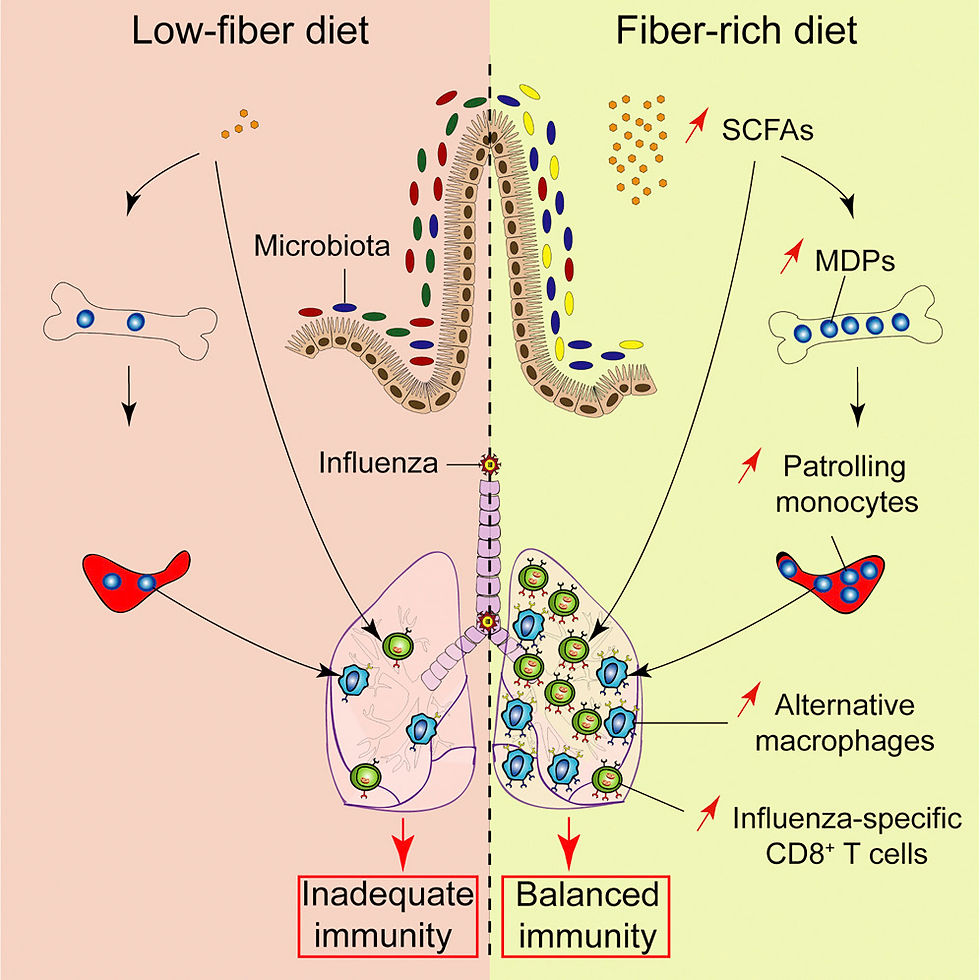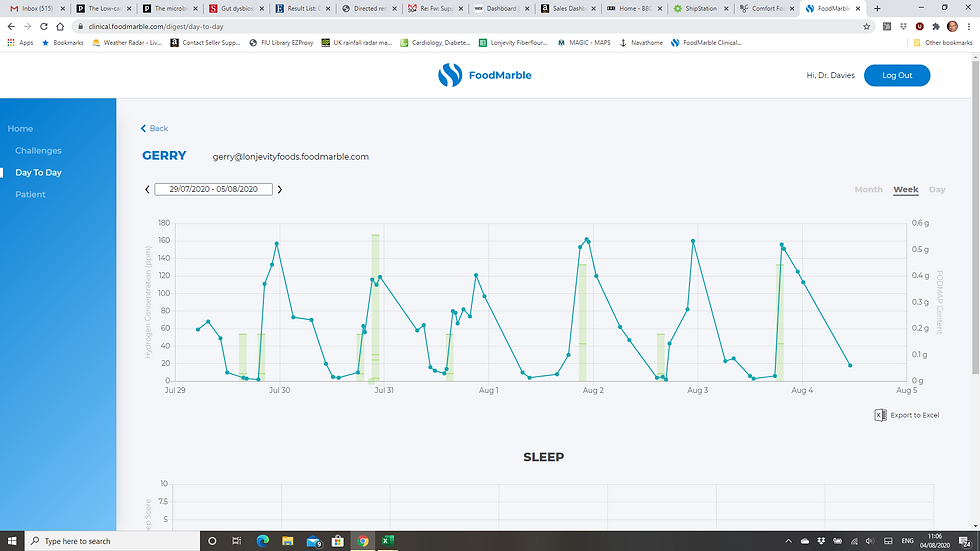Inflammation & Fibre: Mechanisms of Health Benefits
- Dr. Gerald Davies

- Oct 25, 2020
- 4 min read
Updated: Aug 8, 2021
Why is there such a huge variability in the severity of corona virus infection: from no symptoms at all to lung failure, toxic shock and death? The answer is invariably associated with a disordered immune system.
An incredible study by Trompette et al from Lausanne published in 2018 report that a diet rich in fermentable fiber that in turn produces —short-chain fatty acids—mainly butyrate, improves the response of mice to influenza infection. The authors summarise their work in the last paragraph of their paper:
In summary, our data demonstrate that dietary fiber and SCFAs can protect against severe influenza infection by reducing tissue damage and by boosting adaptive anti-viral immunity. SCFAs have predominantly been associated with immunoregulation and the prevention of exaggerated inflammation (Maslowski et al., 2009,
Trompette et al., 2014); however, our work highlights a dual role of SCFAs. By tuning down excessive innate responses, promoting tissue-protective mechanisms, and stimulating specific adaptive immunity, dietary fiber and SCFAs can create an immune balance that ultimately protects against disease.
The study was done on mice infected with flu but it is likely that the same mechanisms are at work in humans with the corona virus. For instance just 15g of fibre supplement per day for 2 weeks reduced inflammatory markers and joint inflammation in people with arthritis. Another study of human immune cells outside the body in cell culture systems found butyrate was also profoundly anti-inflammatory. Several research groups have suggested high fibre intake should help prevent or treat severe respiratory distress from Covid. Although this approach makes a lot of sense I have not found any published studies treating Covid with fibre supplements in humans as yet, but the smart bet is to act on these exciting findings and get as much fibre as you can: there are hundreds if not thousands of studies showing improved all cause mortality with higher fibre intakes and not one showing any harm.
The figure shows SFCAs (short chain fatty acids), mainly butyrate increased the number of anti-inflammatory young immune cells (MDPs) in bone marrow which transform into scavenging "pacman" like cells in sites of infection and when these anti-inflammatory "alternative" type 2 macrophages move to the infected lung produce healing. Without the influence of butyrate "inflammatory" type 1 macrophages predominate and have the potential to cause a runaway self harm and Severe Adult Respiratory Distress Syndrome (SARS). They also found that SCFAs promoted the production of the cells that are capable of killing the virus (CD8+Tcells) and increased their efficiency at clearing the virus

Optimal Fiber Intake?
Despite the numerous health benefits of fibre and pre-biotics most people consume less than half the 30g recommended daily amount where we really need something in excess of 50g of fibre a day to be of maximum benefit. The amount of short chain fatty acids produced by the gut microbes correspond to how much fiber you eat and new evidence regarding the vital roles of butyrate suggests optimal fiber intake needs re-evaluation; hunter gatherer populations customarily consume in excess of 100g/day and experience far fewer metabolic disorders. However, to achieve weight loss or diabetes remission, there is a problem with obtaining adequate fibre from whole grain wheat flour which is nevertheless a high glycemic/insulinemic food and 40g a day of fibre from whole-wheat flour comes with 250g (1000 kcals) of additional high glycemic starch. On the other hand it is impractical to consume large volumes of vegetables, for example you would need to eat 1.7 kg of broccoli to get 40g of fibre. Alternatively, replacing starch with innovative prebiotic fiber ingredients in basic baking flour in everyday comfort foods can easily achieve high fiber intake with a negligible glucose and insulin response.
Population studies have consistently shown higher fibre intake is associated with decreased cardio-vascular disease, diabetes and all-cause mortality. The short chain fatty acids especially butyrate are of particular importance with numerous functions in the wider organism as well as the gut and must soon be recognized as essential nutrients for optimal health.

Fibre deficiency is being increasingly recognised as vitally important in view of all these new discoveries in immunology and it may contribute to cytokine storms in some individuals who contract flu and Coronavirus as it has already been linked to other autoimmune conditions like asthma, celiac disease, T1diabetes, arthritis, etc.
How to tell if you're producing butyrate? Simple: No Gas No Gain
Microbes have many more enzymes than us mammals, bacteria breakdown fibre into glucose and obtain energy for themselves converting glucose into acetic acid and other bacteria gain by converting acetate into butyrate. As you can see in the fermentation equation below: 6 molecules of gases are given off for every 2 molecules of acetate. This is a long shot but, we really need to change our attitude to flatus and celebrate it knowing that every indiscretion has also produced life enhancing SCFAs.

In addition to butyrate, there is another potential beneficial product of fibre fermentation. Hydrogen makes up more than 60% of intestinal gas and has well described anti-oxidant and anti-inflammatory properties. The graph below shows hydrogen levels in my breath measured with the Foodmarble Hydrogen Monitor (contact me if interested in monitoring your H2 in response to high fibre intake). Several Chinese doctors are enthusiastic about using H2 in the treatment of Covid.

The take home message: Fibre could protect you from serious complications of Covid
Replace high glycemic carbohydrate with fibre for all sorts of health benefits: click on bullets for original source.



Thank you for sharing this detailed and well-researched post. The connection between dietary fiber, SCFAs (especially butyrate), and immune modulation is incredibly important, particularly in the context of respiratory infections like Covid-19. It’s fascinating how gut health can influence systemic inflammation and immune response, and the Trompette et al. study offers compelling insights.
As someone who has discussed similar concepts with my heart doctor, I can confirm that there's growing recognition in cardiology about the systemic benefits of fiber—not just for blood sugar regulation or digestion, but for reducing cardiovascular inflammation and even modulating blood pressure. High-fiber diets contribute to a healthier microbiome, which in turn influences everything from arterial function to immune resilience.
The idea that fibre deficiency might…